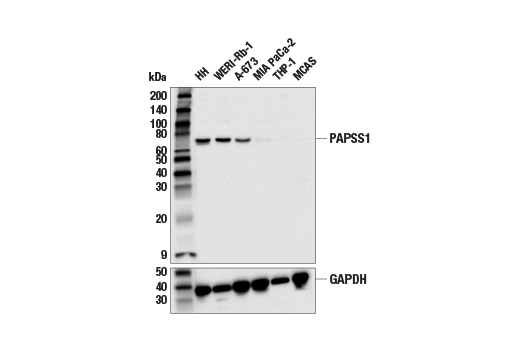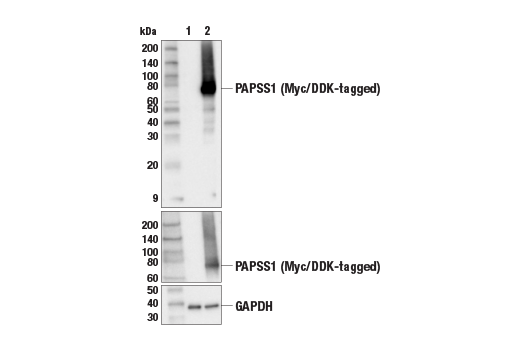WB
H
Endogenous
70
Rabbit
#O43252
9061
Product Information
Product Usage Information
| Application | Dilution |
|---|---|
| Western Blotting | 1:1000 |
Storage
Specificity / Sensitivity
Species Reactivity:
Human
Source / Purification
Polyclonal antibodies are produced by immunizing animals with a synthetic peptide corresponding to residues surrounding Pro255 of human PAPSS1 protein. Antibodies are purified by peptide affinity chromatography.
Background
PAPS Synthase 1 and 2 (PAPSS1, PAPSS2) are bifunctional enzymes with both ATP sulfurylase and APS kinase activity. They mediate two reactions to generate 3'-phosphoadenosine-5'-phosphosulfate (PAPS), a critical intermediate in the sulfate activation pathway. PAPS is the sulfate donor co-substrate for all sulfotransferase (SULT) enzymes and is required to catalyze the sulfate conjugation of many endogenous and exogenous compounds (1,2). For example, PAPSS1 and PAPSS2 are responsible for catalyzing the sulfation of steroid hormones, which increases their water solubility and reduces their biological activity, suggesting modulation of PAPS synthases as a possible avenue for treatment of hormone-dependent cancers (3). Inhibition of PAPSS1 was also shown to increase the sensitivity of some cancer cell lines to DNA-damage agents both in vitro and in vivo (4,5), suggesting further potential utility for PAPS synthase inhibitors in cancer therapy.
Species Reactivity
Species reactivity is determined by testing in at least one approved application (e.g., western blot).
Western Blot Buffer
IMPORTANT: For western blots, incubate membrane with diluted primary antibody in 5% w/v BSA, 1X TBS, 0.1% Tween® 20 at 4°C with gentle shaking, overnight.
Applications Key
WB: Western Blotting
Cross-Reactivity Key
H: human M: mouse R: rat Hm: hamster Mk: monkey Vir: virus Mi: mink C: chicken Dm: D. melanogaster X: Xenopus Z: zebrafish B: bovine Dg: dog Pg: pig Sc: S. cerevisiae Ce: C. elegans Hr: horse GP: Guinea Pig Rab: rabbit All: all species expected
Trademarks and Patents
Limited Uses
Except as otherwise expressly agreed in a writing signed by a legally authorized representative of CST, the following terms apply to Products provided by CST, its affiliates or its distributors. Any Customer's terms and conditions that are in addition to, or different from, those contained herein, unless separately accepted in writing by a legally authorized representative of CST, are rejected and are of no force or effect.
Products are labeled with For Research Use Only or a similar labeling statement and have not been approved, cleared, or licensed by the FDA or other regulatory foreign or domestic entity, for any purpose. Customer shall not use any Product for any diagnostic or therapeutic purpose, or otherwise in any manner that conflicts with its labeling statement. Products sold or licensed by CST are provided for Customer as the end-user and solely for research and development uses. Any use of Product for diagnostic, prophylactic or therapeutic purposes, or any purchase of Product for resale (alone or as a component) or other commercial purpose, requires a separate license from CST. Customer shall (a) not sell, license, loan, donate or otherwise transfer or make available any Product to any third party, whether alone or in combination with other materials, or use the Products to manufacture any commercial products, (b) not copy, modify, reverse engineer, decompile, disassemble or otherwise attempt to discover the underlying structure or technology of the Products, or use the Products for the purpose of developing any products or services that would compete with CST products or services, (c) not alter or remove from the Products any trademarks, trade names, logos, patent or copyright notices or markings, (d) use the Products solely in accordance with CST Product Terms of Sale and any applicable documentation, and (e) comply with any license, terms of service or similar agreement with respect to any third party products or services used by Customer in connection with the Products.

